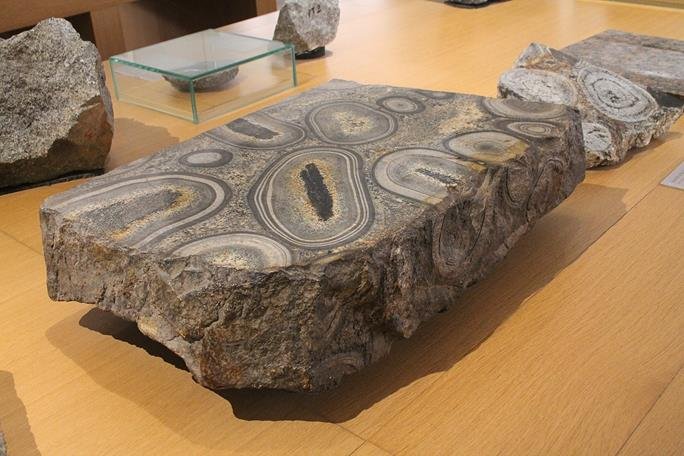Orbicular texture or fabric describes rocks with many large ovoid or spheroidal structures called orbs or orbicules. Orbs are concentric shells of alternating texture and/or mineral composition formed around a central core.
These bodies are also called orbicular structures. Their sizes range from a few to tens of centimeters. You will see these structures with an unaided eye.
Usually, the concentric shells or banded structures in orbicules are defined by the varying texture and/or mineral composition. However, the color and composition of these concentric layers can vary from the core outward.
How do they form? Orbicules form from radial and/or tangential growth of elongated or needle-like crystals of amphiboles, pyroxenes, micas, and plagioclase.

Lastly, this texture can occur in various igneous rocks, including the fine-grained extrusive to coarse-grained intrusive igneous rocks. Also, they are known in some metamorphic rocks.
Orbicular texture description
Orbicular texture or rocks have large, spheroidal structures with rhythmic alternating concentric shells of varying mineral composition and/or textures around a central core.
This delicate modal banding results from elongated crystals or rings growing radially or along the radii.
1. Shape and size
Orbicules are spheroidal to ellipsoidal. However, some are fragmented or irregular. This happens due to deformation, assimilation, or replacement.
Furthermore, orbs, or orbicules, are a few centimeters to tens of centimeters in diameter. However, most are 5-10 cm, with some less than 3 cm and more than 30 cm.
Lastly, each orb can have 1 to over 20 sheets or concentric rings. These rings or shells are irregularly spaced or may show some geometric progression.
2. Orbicule cores
Their core may be xenoliths (foreign rock fragments) or autoliths (earlier crystallized rock fragments). Also, early-formed orbicules or orb fragments can serve as a core.
That is not all. Orbicular rock cores in recrystallized metamorphic rocks can be a remnant of protolith, i.e., metamorphosized original parent rock, recrystallized country rock, or metamorphic differentiates.
However, some orbicular structures don’t have a core. Such form around an imaginary center with no core.
3. Composition
Orbs have essentially feldspars (plagioclase and alkali feldspar) and quartz. Also, they will have biotite and sometimes hornblende. These are nothing other than granitic minerals.
Please note that the composition of these structures can resemble or be distinctive to the rocks in which they occur.
4. Texture
The core and shell can be granular inside the orb or have elongated crystals arranged radially. The crystal texture may vary, too.
Where does orbicular texture occur
Orbicular rocks occur in all continents. Host rocks for orbicules can be ultramafic, mafic, intermediate to felsic igneous, and their corresponding metamorphic rocks with fine-grained to coarse-grained textures.
Specific rocks include granitoids, monzodiorites, diorites, syenites, gneisses, migmatites, schists, etc. These rocks can occur in lava, stocks, batholiths, sills, dikes, or metamorphic terranes.
In host rocks, orbicules are local, i.e., they occur in small areas relative to the large rock masses, especially pluton margins. Typical orbicular facies are only several hundreds of meters where they can be closely crowded or thinly disseminated.
Furthermore, these structures can be the same or distinctive within a locality and have single to multi-layered shells.
Lastly, orbicular rocks may also have xenoliths, phenocrysts, protoorbicules, and porphyroblasts. Also, these rocks can show mineralogical layering and have mineral segregations or nonorbicular nodules.
How does orbicular texture form?
Many theories attempt to explain the origin of orbiculates in rocks, which include:
- Formation of immiscible drops within a magma body.
- A reaction between magma and a xenolithic rock inside the magma. Xenoliths are foreign rock bodies enclosed in magma or an igneous rock body.
- A change in melt’s eutectoid is due to temperature, pressure, or both variations. Eutectoid characterizes a magma melt with a single melting point lower than that of any of the components.
- A core migrating through magma portions with varying composition
- Supersaturation and crystallization happen in a rhythmic magma from a given center. It’s more like how Liesegang rings form.
- A metamorphic process involving diffusion and rhythmic precipitation during granitization.
Related structures
Some of the common structures related to orbicular texture include the following:
1. Corsite
Corsite is a light-colored orbicular diorite from the Island of Corsica in France. It has calcic plagioclase, hornblende and minor enstatite and quartz.
They serve as ornamental stones and go by names like miagite, kugeldiorite, and napoleonite.
2. Orbicular jasper
Oceanic orbicular jasper, or just orbicular jasper, has colorful orbs or concentric shelled structures.
It is a highly silicified rhyolite or tuff in which feldspar and quartz crystallize into radially arranged circular or needle-like crystals. This creates the orbicular concentric shells.
Orbs in this jasper vary from tiny round dots to larger ones. Some are irregular and are over an inch in size.
Places where orbicular jasper occurs include Madagascar with Morgan Hill and Ocean Jasper, and California has the Poppy Jasper.
Other areas where it is found include Africa, India, and Mexico. Also, it occurs in different states in the US, such as Nevada, Montana, Oregon, and Texas.
Lastly, their uses include making jewelry parts, such as cabochons or beads. Also, collectors value it.
3. Psilomelane
They have silver and black swirls of orbicular pattern that resemble what you see in malachite.
Orbicular rock uses
The spectacular appearance of concentric layers of orbicules makes rocks valued as polished or dimensional stones with this texture.
Also, some are cut into cabochons for display or used to make beads or pieces for some jewelry.
